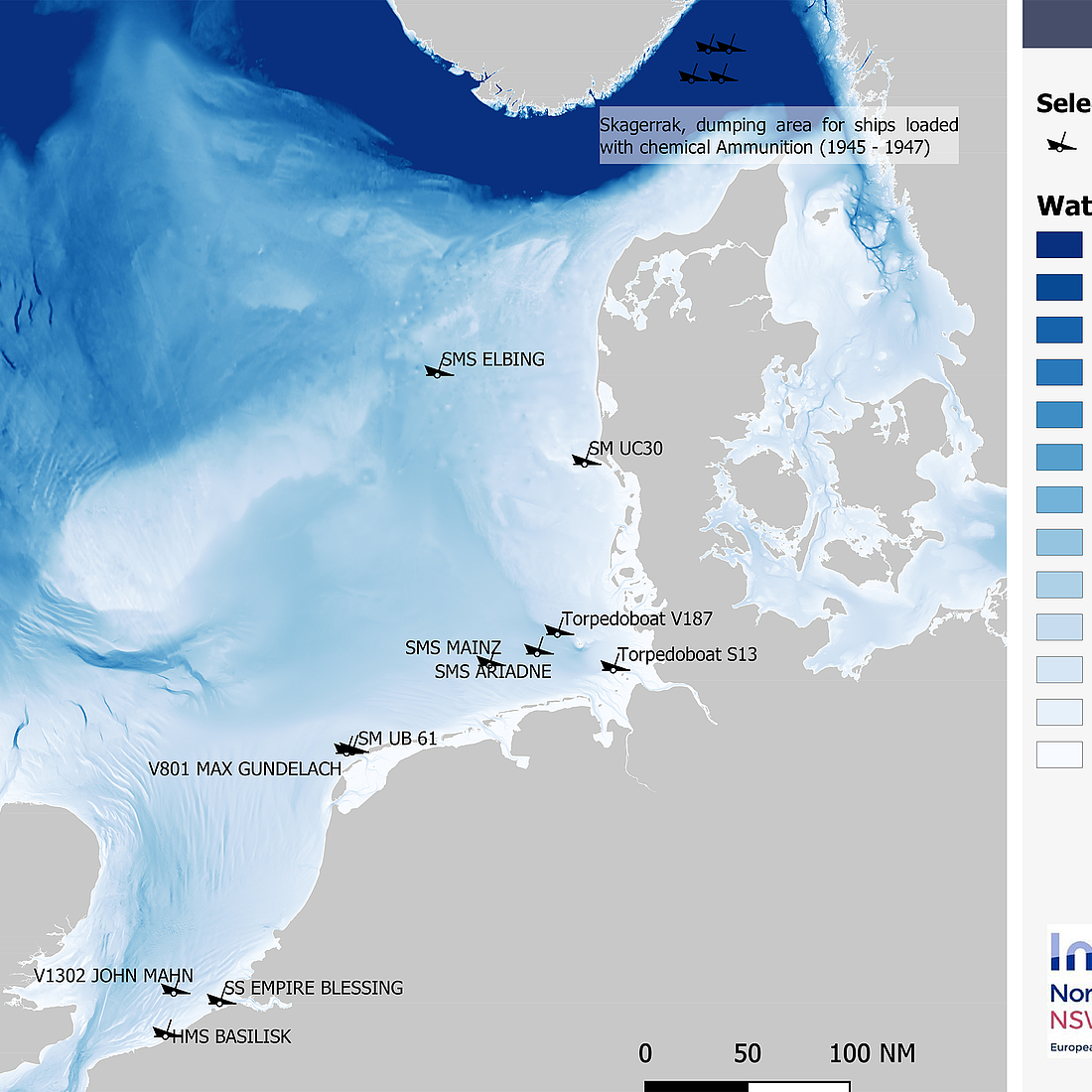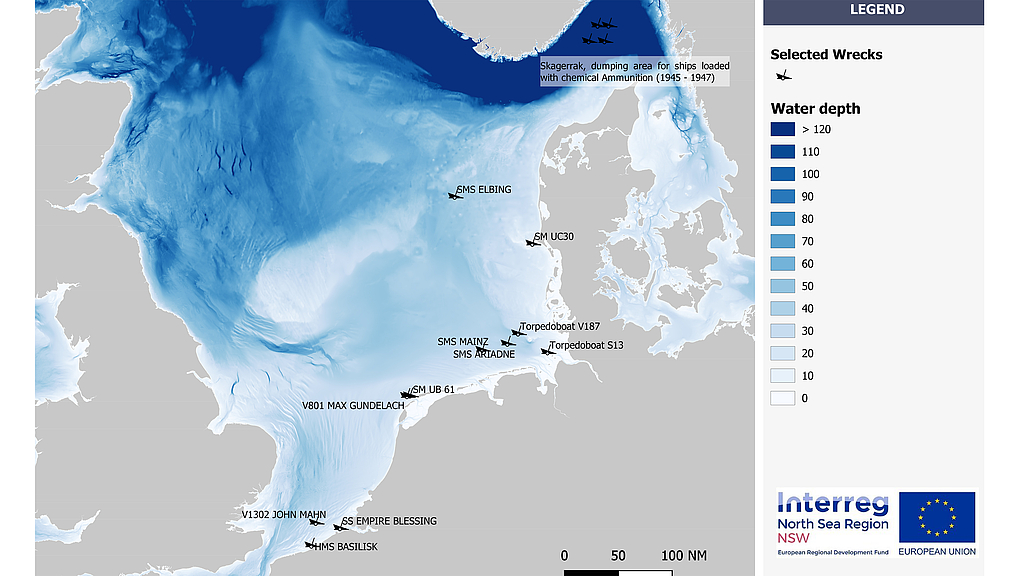Research Cruises and selected wrecks
Belgian research cruises 2019-2020
Report from the Heincke expedition of 6-11 Apr. 2021
Given that the North Sea is extensively littered with wrecks, we have to select some identified war wrecks as case studies for the project. We plan to visit these wrecks during the research cruises. As the project is still ongoing, the possible wreck sites worthy of sampling have not all been selected nor are all of the already chosen sites fully researched. So additional research cruises will happen.
⇒ If you like to know more about the research methods, please see Station 3.
⇒ And if you want to find out what 3D animations of the wrecks look like, click here.
selected wrecks
-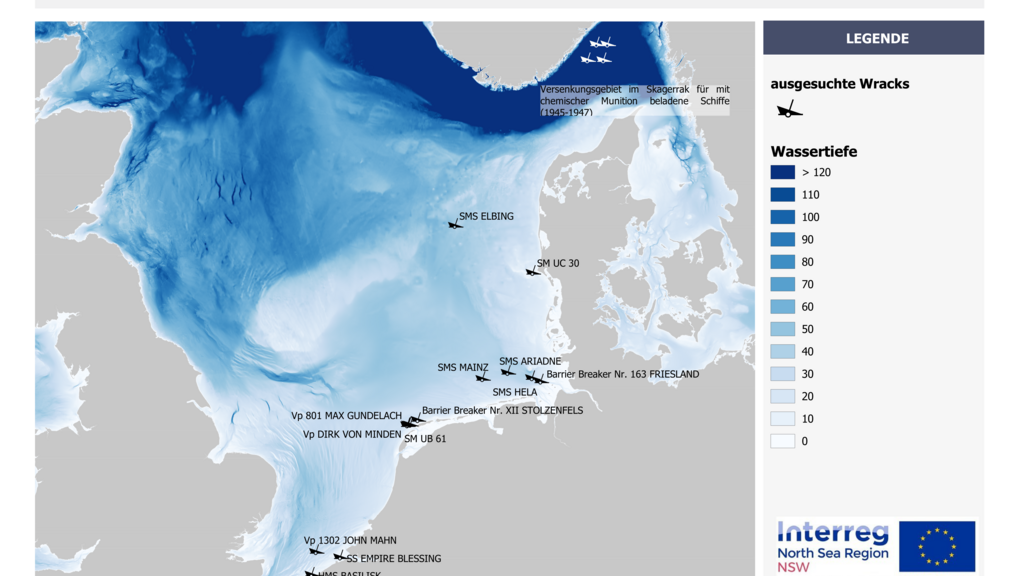
Selected identified war wrecks as case studies for the project. © north.io
Different wrecks were investigated in the project, which are presented here on this page. The partners involved are:
- Alfred-Wegener-Institute,Helmholtz Centre for Polar and Marine Research (AWI)
- Aarhus University, Department of Geoscience (AU)
- German Maritime Museum, Leibniz Institute for Maritime History (DSM)
- NHL Stenden, University of Applied Sciences, Maritime Institute Willem Barentsz (NHL)
- University Medical School Schleswig-Holstein, Institute of Toxicology and Pharmacology (UKSH)
- Norwegian Defence Research Establishment (FFI)
- Flanders Marine Institute (VLIZ)
By the Belgian Flanders Marine Institute, some further wrecks were examined for the project: Torpilleur BOURRASQUE, Harbour secure Boat KW 58 HENDERICUS, Torpedo Boat G 96, Motor Torpedo Boat S 185, submarine SM U 11, Barrier Breaker Nr. 141 LIES and an unidentified submarine type UB-III. For further information about these wrecks see. (link: https://wrakkendatabank.afdelingkust.be/)
HMS BASILISK
-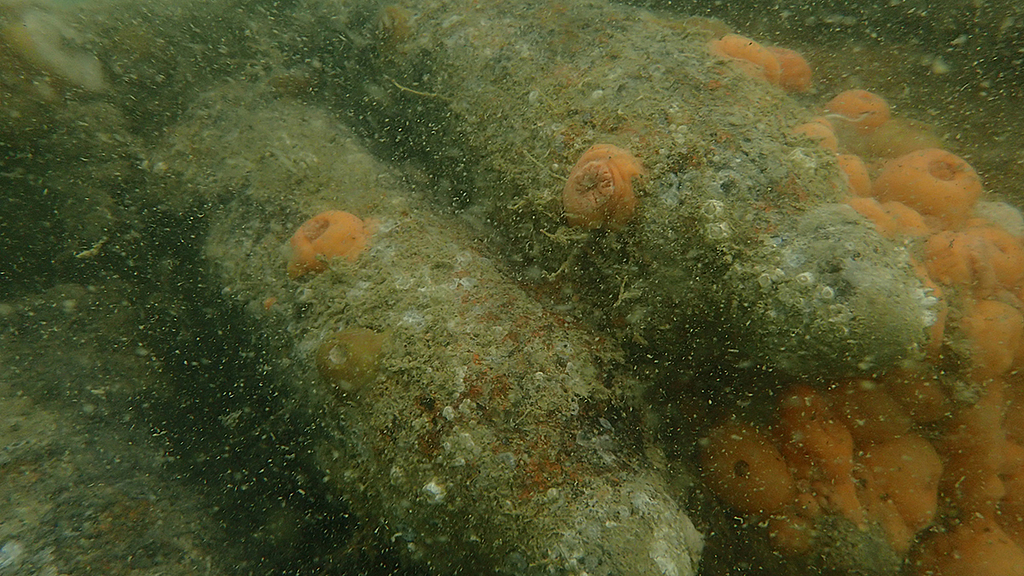
Pile of 120 mm grenades on the wreck of the British destroyer HMS BASILISK. Ship sunk after serious damage through German aircrafts at 01.06.1940 © Vlaams Instituut voor de Zee
- built 1929 by J. Brown Company in Clydebank, Building Nr.: 531
- ordered 04.03.1929, laid down: 19.08.1929, launched: 06.08.1930
- Destroyer B-Class
- Displacement: 1.821 t (full loaded), Length: 98.45 m, Width: 9.83 m, Draught: 3.73 m
- speed: 35 kn max. and 31.5 kn in full loaded condition
- fuel: oil
- range: 4.800 nm by 15 kn and 380 t oil
- power unit:
3 Admiralty-Drum Boiler
2 Brown-Curtis Turbines - crew: 138
Armament
- 4 Quickfiring Guns (4.7 inch / 12 cm)
- 2 Quickfiring Guns (2 pdr./ 4 cm)
- 4 Lewis Guns
- 2 Quadruplet Torpedo tubes:
diameter 21 inch / 53.3 cm) each tube
probably type Mk IX - 15 Depth charges (type Mark VII was standard)
SMS ARIADNE
-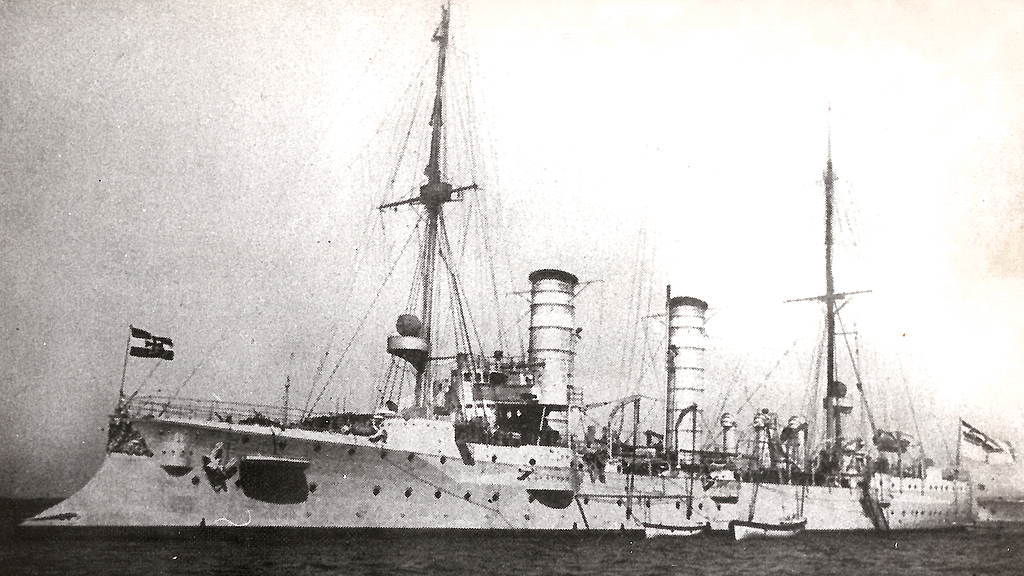
Light Cruiser SMS ARIADNE. Source: Photo Archive German Maritime Museum
- built 1899/1900 at A.G. Weser in Bremen, Building-Nr.: 127
- launch: 10.08.1900, commission: 18.05.1901
- light cruiser (Class IV), GAZELLE-Class
- Displacement: 3.006 t, Length: 105.1 m, Width: 12.2 m, Height: ca. 7.50 m, Draught: 5.50 m
- speed: max. 21.5 kn
- fuel: coal
- range: 3.560 nm with 12 kn and 560 t coal
- power unit: 2 standing 3zyl.-triple expansion-engine and 9 naval boiler in 2 boiler rooms which lying in a row
- 1 rudder and 2 propeller, each 3.5 m in diameter
- cross-frame steel construction with 12 waterproof sections
- double-bottom on 40 % of CWL-length of ship
- armour:
2 steel layers and one Krupp-Nickel-Steel layer, additional Cork dam
deck = 20 mm - 25 mm thick vertical from aft to fore ship
deck = 50 mm thick horizontal from aft to fore ship
coaming = 80 mm thick
Krupp-Steel (Kruppstahl) at Commando tower = 20 mm thick vertical
and 80 mm thick horizontal
gun shields = 50 mm thick - crew: 257
Armament
- 10 Quickfiring Guns (10.5 cm)
- 10 Machine Canon (3.7 cm, unclear if guns were really installed. Sources contradicting in this point)
- 2 Torpedo launching tubes (between frame Nr.: 62 and 68)
diameter 45 cm each
5 Torpedoes (Type: C/03 or C/06)
SMS ELBING
-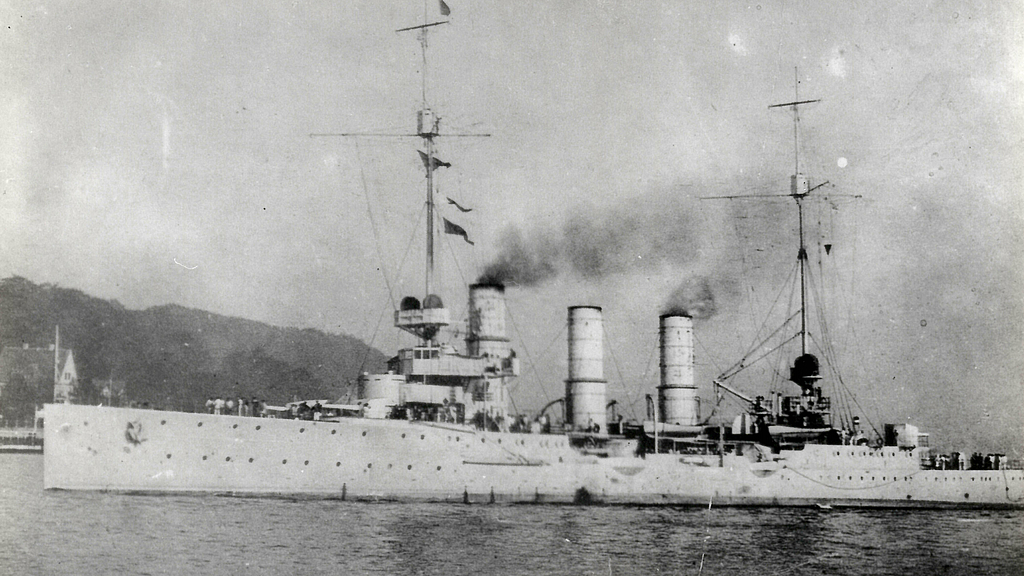
Light Cruiser SMS ELBING. Source: Photo Archive German Maritime Museum
- Displacement: 5.252 t, 3.202 GRT, Length: 135.60 m, Width: 13.60 m, Height: 8.15 m, Draught: 5.98 m
- speed: 27.5 kn max.
- fuel: coal (620 t max.) and oil (580 t max.)
- range: 4.300 nm with 12 kn
- power unit:
6 Yarrow-Watertube-Doubleboiler for coal firing
4 Yarrow-Watertube-Doubleboiler for oil firing
1 rudder
2 propeller each 3.50 m diameter - cross-frame steel construction with 16 waterproof sections (design plan: 1912)
- double-bottom on 51 % of CWL-length of ship
- armour:
2 steel layers and one Krupp-Nickel-Steel layer
deck = 20 mm - 80 mm thick vertical from aft to fore ship
deck = 40 mm thick horizontal from aft to fore ship
Krupp-Steel (Kruppstahl) at Commando tower = 50 mm thick vertical and 75 mm thick horizontal
gun shields = 50 mm thick - crew: 442
Armament
- 8 Quickfiring Guns (15 cm)
- 2 Quickfiring Guns (8.8 cm)
- 2 deck torpedo tubes
each 50 cm diameter
5 torpedoes, type: G6 or G7 ship was capable to carry 120 Mines
Historical Background
SMS HELA
-
SMS HELA before conversion. Source: Photo Archive German Maritime Museum
- built 1893/94 at A.G. Weser in Bremen, Building-Nr.: 108
launch: 28.03.1895, commission: 03.05.1896
first used as AVISO, later and after some conversions used as Light Cruiser
Displacement (after latest conversion): 1.344 GRT and 2.027 t, length: 105 m, width: 11.0 m, height: 6.41 m, draught: 4.64 m
speed: 20.5 kn max.
fuel: coal, max. 412 t
range: max.
- power unit:
- 2 standing 3-cyl. 3-time expansion engines
- 2 triple wing propeller, each propeller with 3.25 m diameter
- 2 engine rooms
- 8 navy boiler
- 2 funnels
- crew: 195
Armament:
- 3 Quickfiring Guns (cal. 8.8 cm)
- 4 Quickfiring Guns (cal. 5 cm)
- 2 Machine Guns (cal. 8 mm)
- 3 Torpedo-launching tubes: under water, one each side - starboard and portside, plus one in bow stem, 45 cm diameter each, 8 Torpedoes type: C/03 or C/06
SMS MAINZ
-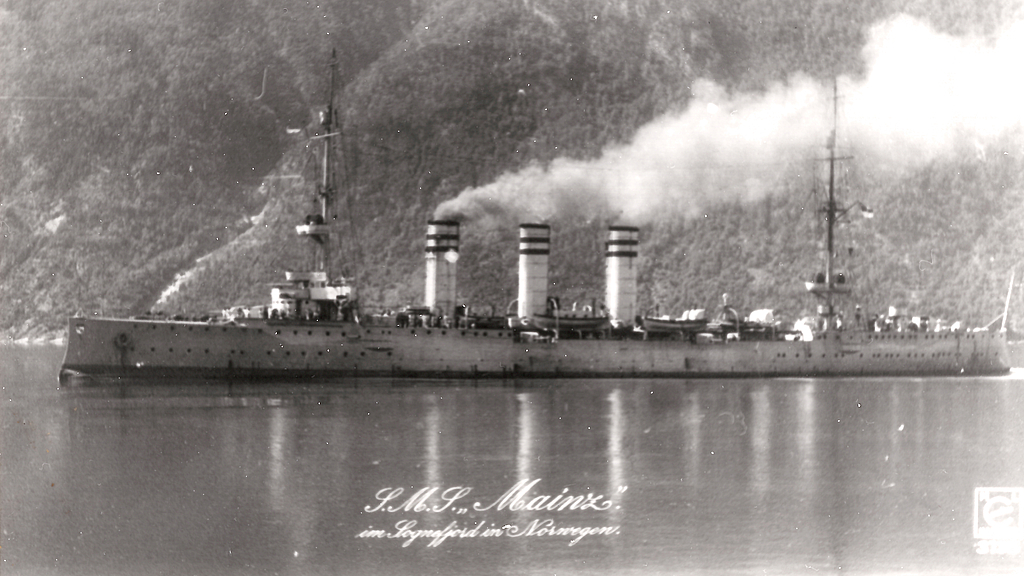
Light Cruiser SMS MAINZ Source: Photo Archive, German Maritime Museum
- built 1907 to 1908 at A.G. Vulcan in Stettin (today Szczecin - Poland), Building-Nr.: 288
- launch: 23.01.1909, commission: 01.10.1909
- light cruiser, KOLBERG-Class
- Displacement: 4.889 t, Length: 130.55 m, Width: 14.0 m, Height: 8.10 m, Draught: 5.60 m
- speed: 26.8 kn max.
- fuel: coal, max. 970 t (plus 40 t payload)
- range: 3.630 nm with 14 kn
- power unitt:
2 AEG Curtiss-Turbines
2 triple wing propeller, each propeller with 3.45 m diameter
4 engine rooms (2 adjacent respectively)
15 navy boilers
3 funnels
cross-frame steel construction with 13 waterproof sections
double-bottom on 50 % of CWL-length of ship - armour:
2 steel layers and one Krupp-Nickel-Steel layer, additional Cork dam
deck = 20 mm - 40 mm - 20 mm thick vertical (slop) from aft over amidships to fore ship
50 - 80 mm thick horizontal from aft to fore ship
coaming = 100 mm thick
Kruppsteel (Kruppstahl) at Commando tower = 20 mm thick vertical (slope) and 100 mm thick horizontal
gun shields
Armament
- 12 Quickfiring Guns (10.5 cm)
- 2 Torpedo launching tubes
between frame 84-92, 45 cm diameter each, 5 Torpedoes type: C/06 - 2 machine guns (8 mm)
- 56 rifles and 28 pistols
SM UB 61
-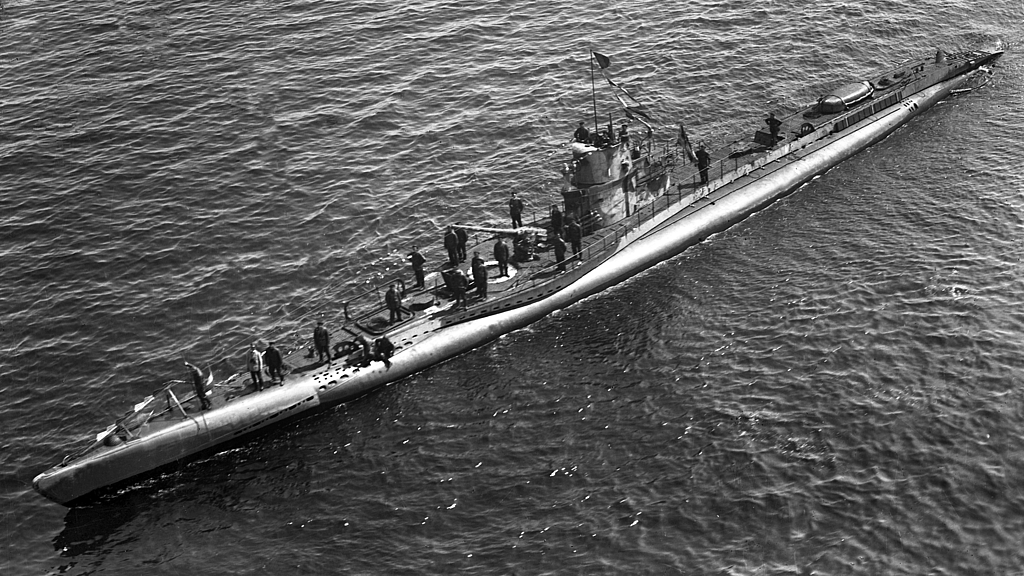
SM UB 64 (identical in construction to SM UB 61) Copyright: WZ-Bilddienst
- built 1916 - 1917 at A.G. Vulcan in Hamburg, Building-Nr.: 86
- launch: 28.04. 1917, commission: 23.06. 1917
- Displacement: 508 t (surface) und 639 t (dived), Length: 55.52 m, Width: 5.75 m, Draught: 3.70 m, Height: keel to tower 8.25 m
- speed: max. 13.3 kn (surface) and max. 8 kn (dived)
- range: 8.420 nm with 6 kn (surface) and 55 nm with 5 kn (dived)
- UB type III, double-hull boat (Zweihüllen-Boot)
Design Proj. 44 (1915/16), War Order Nr. J - 6 waterproof sections
- max. dive depth: 75 m
- fuel: oil with 68 t max.
- power unit
2 MAN-six-cylinder 4-stroke Diesel engine (S6 V35/35) with 1100 PS (surface)
2 Siemens-Schuckert Werke doublemodyn with 580 PS (dived) - crew: 34
Armament
- 5 torpedo tubes (4 bow, 1 stern)
50 cm diameter each
10 torpedoes, Type G6 or G7 - 1 Quickfiring Gun with Torpedo Boat mounting (8.8 cm)
- 2 machine guns (8 mm)
SM UC 30
-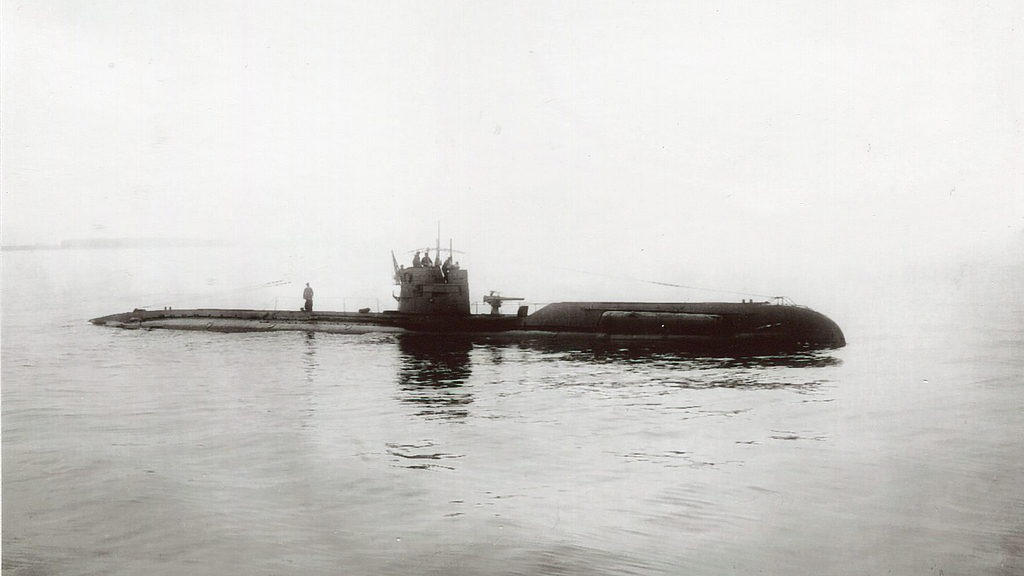
SM UC 30. Copyright: Deutsches U-Boot-Museum, Cuxhaven-Altenbruch
- built 1915-1916 at A.G. Vulcan in Hamburg, Building-Nr.: 70
- launch: 27.07.1916, commission: 22.08.1916
- Displacement: 400 t (surface) und 480-550 t (dived), Length: 51.12 m,
Width: 5.22 m, Draught: 3.68 m (surface), Height: 7.46 m (keel to tower) - speed: 11.6 kn max. (surface) and 6.7 kn max. (dived)
- range: max. 9.410 nm with 7 kn (surface) und 53 nm with 4 kn (dived)
- UC Type II, double-hull boat (Zweihüllen-Boot):Design proj. 41 from 1915,
War Order Nr. C - 7 waterproof sections
- max. dive depth 50 m
- fuel: max. 55 t oil
- power unit: 2 Daimler-sixszylinder-4-stroke-Dieselengine MU 256 with 66 PS (surface),
2 Siemens-Schuckert Werke doublemodyn with 340 PS (dived) - crew: 27
Armament
- 18 mines (type: UC 200) in 6 mine wells (100 cm diameter each)
- 3 torpedo tubes (2 bow above water, 1 stern under water)
- 50 cm diameter
- 7 torpedoes (type: G6 or G7)
- 1 Quickfiring Gun with Torpedo Boat mounting (8.8 cm)
- 1 machine gun (8 mm)
Vp 801 MAX GUNDELACH
-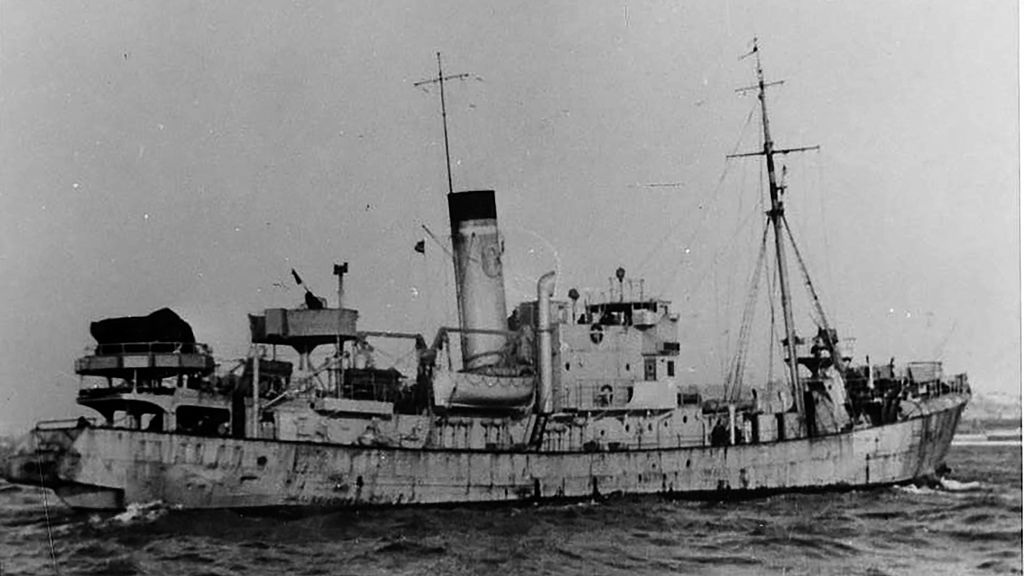
Vp 801 MAX GUNDELACH after War Modification. Source: Photo Archive German Maritime Museum
- built in 1940 at Deschimag-Werk Seebeck in Wesermünde-Geestemünde (today Bremerhaven), Building-Nr.: 641
- 505 GRT, Displacement ca. 1.290 t, Length: 55.90 m, Width: 9.16 m, Height: 4.79 m
- speed: max. 12.3 kn
- fuel: coal
- range: 7.000 nm with 12 kn and 260 t coal
- power unit:
3-time expansion engine with Abd.-turbine and one boiler - crew: 52
Armament
- 1 Quickfiring Gun (8.8 cm) on foredeck
- 1 Quickfiring Gun (3.7 cm) stern area
- 2 Flak-quadruplet (2 cm)
- 2 Flak (2 cm)
- 2 Flak (1.5 cm)
- 10 Depth charges (Type: D, F, G or H)
Vp 1302 JOHN MAHN
-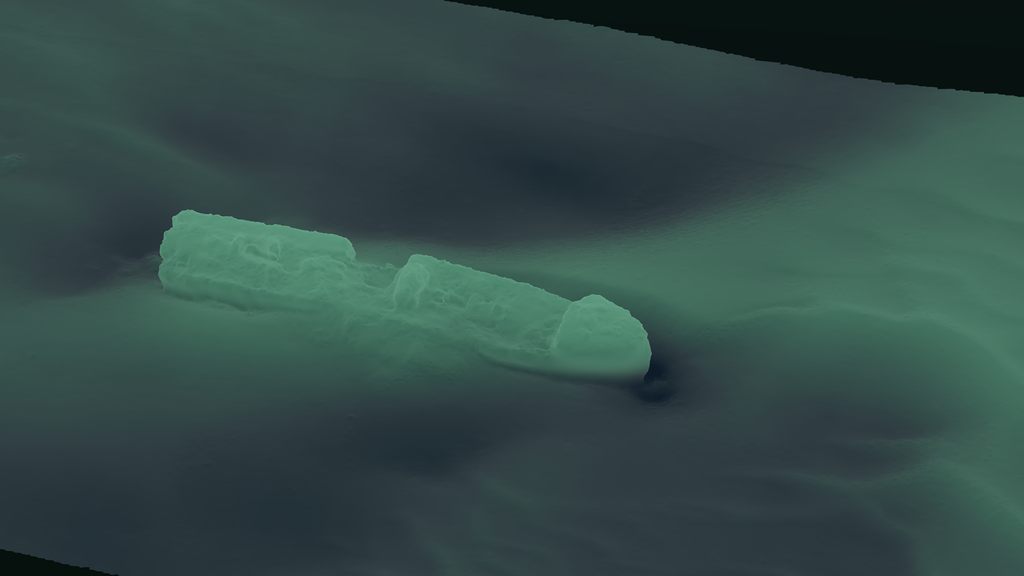
3D-picture of the wreck of the VP 1302 John Mahn. © German Maritime Museum
- built 1927 at Reiherstieg Schiffswerft & Maschinenfabrik in Hamburg, Building-Nr.: 580
- tonnage: ca. 620 t and 292 BRT, Length: 45 m, Width: 7.39 m, Heigth: 4.15 m, Draught: 3.32 m
- speed: max. 11 kn
- fuel: coal
- range: 6.320 nm mit 10 kn and 223 t coal
- power unit:
- 3 time expansion engine with Abd.-turbine and one boiler
- crew: 46
Armament:
- 1 Quickfiring Gun (8.8 cm) or 1 Quickfiring (3.7 cm) on foredeck
- 1 Flak (2 cm) elevated on foredeck
- 1 Flak (2 cm) stern area
- 10 Depth Charges (Typ: D, F, G oder H)
Vp DIRK VON MINDEN
-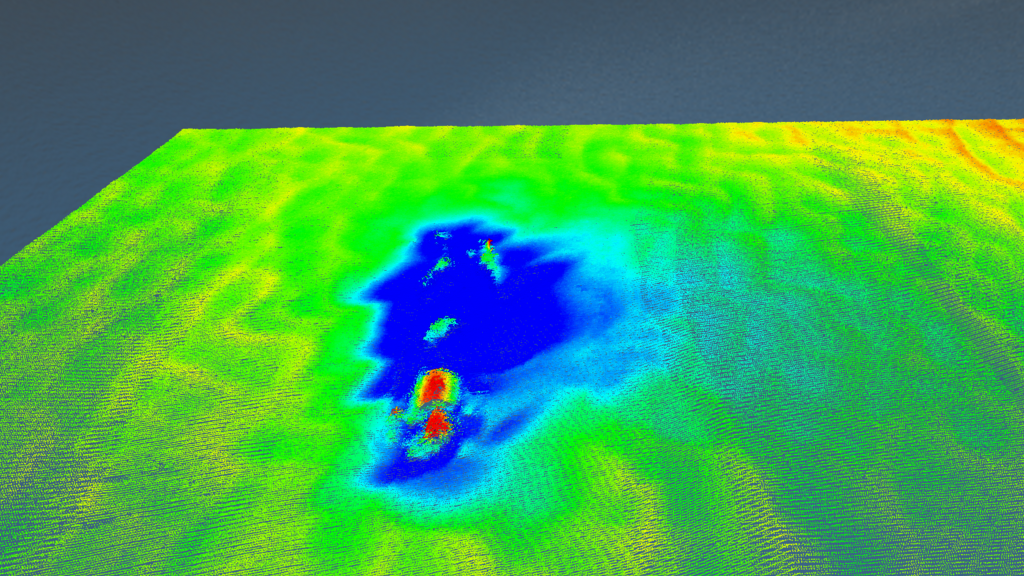
Multibeam-Scan of the wreck site of DIRK VON MINDEN. Wreck is disintegrate and barley visible. Copyright: Maritime Institute Willem Barentsz and Data acquisition G2 Surveys.
- built in 1916 at Reiherstieg Schiffswerft & Maschinenfabrik in Hamburg
- Building-Nr.: 491
- dimensions:
- 220-228 GRT, Displacement: ca. 470 t
- Length: ca. 36.50 m, Width: ca. 7.40 m
- Height: 3.98 m, Draught: ca. 2.90 m
- speed: max. 10.5 kn
- fuel: coal, range: 5.140 nm with 170 t coal
- power unit: one 3-time expansion engine with one boiler
- crew: 22-31
Armament/Equipment (Outpost boats of the Imperial German Navy were generally barely armed):
- 1 Quick-firing gun (cal. 8.8 cm or 5.2 cm)
- 1 Machine-canon (cal. 3.7 cm)
- probably depth charges
- probably fogging bombs
Barrier Breaker Nr. 163 FRIESLAND
-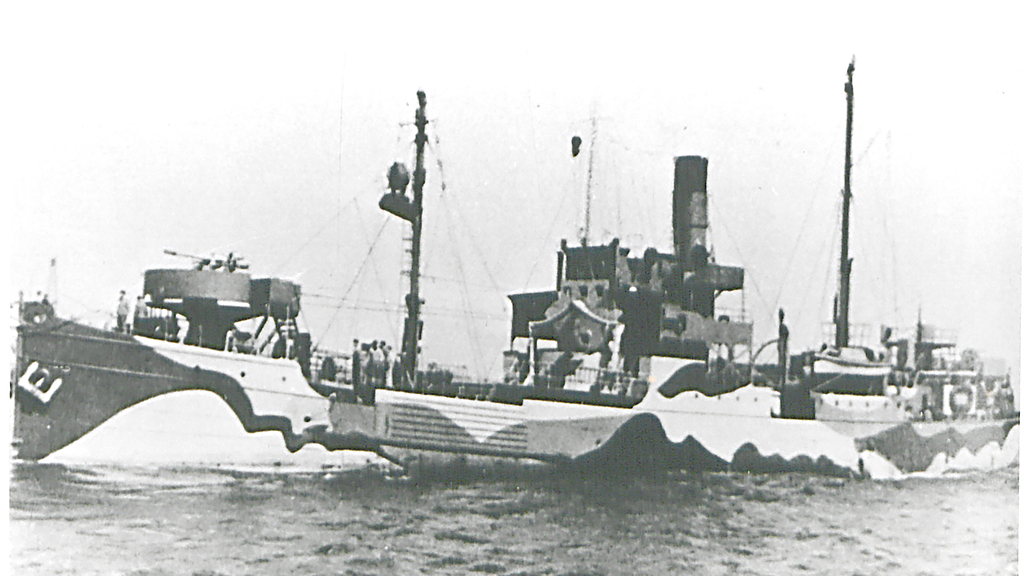
Barrier Breaker Nr. 163 FRIESLAND after War Modification. Date unclear. © BArch-MA MSG 237/3.
- built 1904 at George Brown & Co in Greenock (Scotland)
- Building-Nr.: 24 (first named was S/S WELLPARK)
- Displacement: 1.029 GRT, length: 70.08 m, width: 09.49 m, height: 04.72 m, draught: 04.65 m
- speed: 9 kn max.
- fuel: coal
- power unit: one standing 3 cyl. 3-time expansion engine with 1 boiler
- crew: ca. 80
Armament/Equipment
- 1 Quickfiring Gun (cal. 7.5 cm or 8.8 cm)
- 1 Quickfiring Gun (cal. 3.7 cm)
- 2 Flak (cal. 2 cm)
- VES-System
- Otter-System
- GTB und/oder KKG
Barrier Breaker Nr. XII STOLZENFELS
-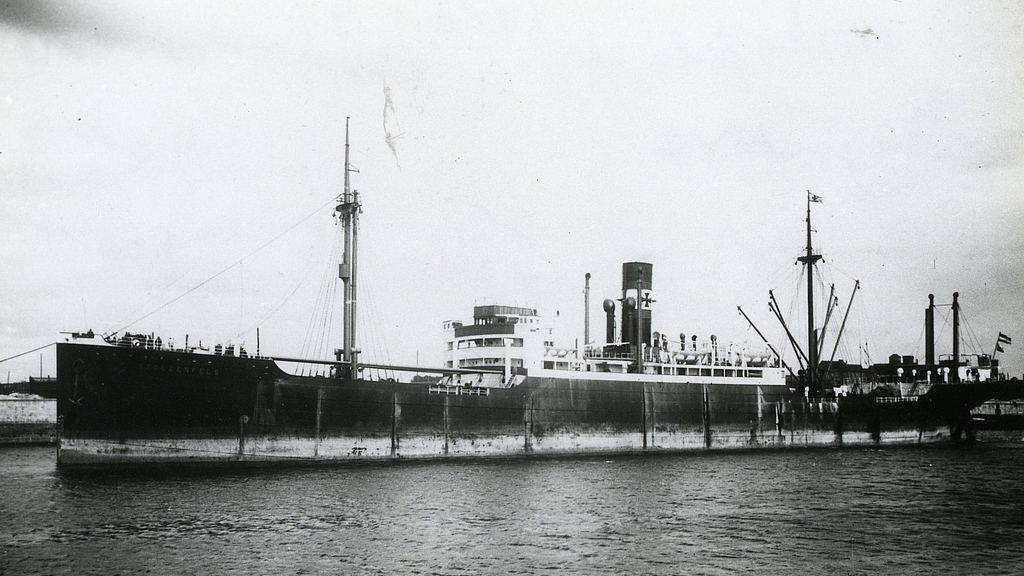
Picture of the ship after 1926. Without war modifications. Quelle: Photoarchive / German Maritime Museum
Technical Information:
- built in 1915 at Tecklenborg in Geestemünde(today Bremerhaven) as ALTENFELS, renamed in 1926 as STOLZENFELS, Building-Nr.: 269
- dimensions:
- 7.512 GRT, Length: 142.78 m, Width: 17.82 m
- Height: 10.50 m, Draught: 8.28 m
- speed: 12 kn max.
- fuel: coal, range: 10.100 nm with 1.692 t coal max.
- power unit: three cyl. 3-time expansion engine with 4 boilers
- crew: ca. 80
Armament/Equipment:
- 1 Quick-firing gun (cal. 10.5 cm)
- 2 Quick-firing twin guns (cal. 3.7 cm)
- 3 Flak (cal. 2 cm)
- VES-System
- Otter-System

